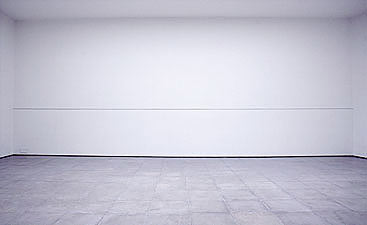
Born in 1968 in Karachi (PK)
Lives and works in London (GB)

2000
Black elastic, fixtures
Dimensions variables
Year of Purchase: 2002
‘What you see is what you see.’1 Frank Stella’s famous phrase set up as a programme-cum-definition-cum-justification of their practice by the founding fathers of Minimal art, has become the rallying cry for those seeking to banish all illusion from art. An authoritarian-sounding injunction that Ceal Floyer deliberately and insidiously sets about subverting by playing on the dialectics between the literal aspect and the construction of meaning. The artist explores the relationship between language and perception by making a slight shift and injecting a touch of derision. Through the titles of her works she insinuates doubt as to the irrefutable character of the nature of the displayed object and questions the immediacy of perception. Thus, Monochrome Till Receipt (White) (2000) is presented as a mere shopping list stuck on the exhibition room wall which, on closer examination of its contents, reveals the solution: every item and products in the list is white in colour (sugar, milk, paper handkerchiefs, talc)!
In Title Variable (2000), the title varies with the dimension of the wall receiving it; thus is one contribution to this reflection on language and on the connection between thinking and seeing. It involves a band of black elastic stretched as far as it will go along the length of a white wall. The specificity of the chosen material is denied twice over, both in its use (being stretched to breaking point, it loses its stretchibility, elasticity) and in its name (for each presentation, the elastic, the length of which is in essence constantly being redefined, is described by a dimension that serves as a title). The title is determined as follows: once the elastic is stretched as far as it will go in the space, its original length is subtracted from its extended length.2 The deliberately absurd title highlights the gap between the arbitrariness of the title (the name) and the interpretation it involves (the dimension announced as the title and the actual length of the wall).
The logic and obviousness – of the word and the measurement – are subverted, proposing an absurd contemporary version of Mel Bochner’s famous Measurements Series. According to one established procedure (Group B: localized measurements), the artist in 1967 began measuring real spaces and transferring the measurements directly onto the walls, thereby underlining the tangibility of the space. Ceal Floyer’s elastic on the other hand invites us mentally to push back the limits and physical properties of the space in which the work is set.
The simplicity of the Ceal Floyer experience, the anti-spectacular character of her devices, often only barely visible, are so subtle they possibly go unnoticed at first glance. As often with this artist, the key to the mystery and to interpreting or even explaining the process is given to us in the word play of the title. No subterfuge, just irony and subtle humour in a language-based paper chase that goes against the austerity, the extreme soberness and seriousness embodied by the exponents of Conceptual and Minimal art.
Hélène Guenin
1 Frank Stella in an interview with Bruce Glaser in ‘Questions to Stella and Judd’, in Regards sur l’art américain des années soixante, 1964.
2 Shown in 2002 at the Lisson Gallery (London), the piece was then titled 3 m 86 cm, 2002 – i.e. the 5 metres of the elastic minus the 1 m 14 cm remaining to be covered.